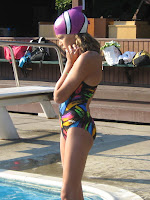I often think of swimming in terms of archery. The swimmer's mind is the archer, the swimmer's body is the arrow, the water is the traversing path, and each wall is the target.
With little or no knowledge of archery, I only use this analogy because of the image it conjures, one of extended, untethered flight, which I would like my swimming students to emulate in their streamlines and the ensuing path of their stroke. I want them to feel a firm reach along their body line; extending upward (or forward) through the crown of their head and downward (or backward) through the tips of their toes, originating at each his own center of gravity (the location of which varies from person to person). On a visceral level I want each swimmer to
experience the source and direction of that extension, from the very core of their center of gravity, up and down through their spine, as rays of light emanate from the sun, which originate from a dense center of mass and reach out to infinity.
In the book Zen in the Art of Archery written by Eugen Herrigel, Herrigel describes Zen in archery as follows:
- "(...) The archer ceases to be conscious of himself as the one who is engaged in hitting the bull's-eye which confronts him. This state of unconscious is realized only when, completely empty and rid of the self, he becomes one with the perfecting of his technical skill, though there is in it something of a quite different order which cannot be attained by any progressive study of the art (...)"
The author describes the archer as "Becoming one with the perfecting of his technical skill" yet follows by saying that this cannot be achieved "By any progressive study of the art." Perhaps the author believes that the archer experiences some kind of metaphysical evolution? But what triggers such a thing, if not a progressive study. Unless, the
ability or
readiness to be one with the perfecting of one's technique is somehow encoded (or not encoded) upon (for lack of a better description) an inner psychic map, or swirling around in the DNA of each individual student of archery... or swimming...
In trying to understand this author's perspective, the concept of kundalini comes to mind, which I find very relevant to balance, efficiency and awakening to the perfecting of one's technique in swimming....
-
-



















